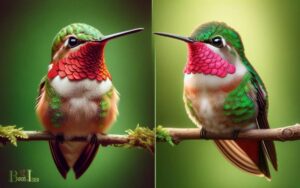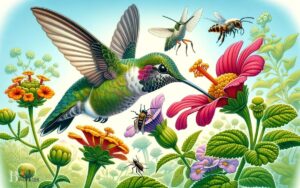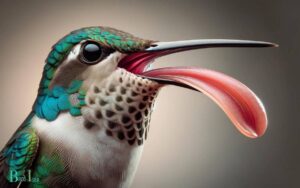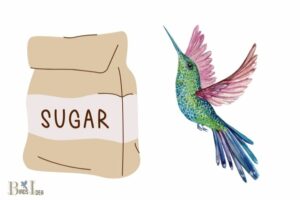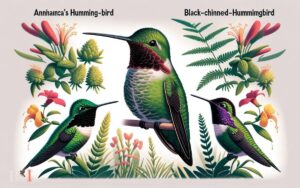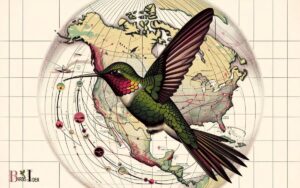Anna’s Hummingbird Nesting Season: December to June!
Anna’s Hummingbird (Calypte anna) typically begins its nesting season earlier than most North American birds.
Nesting can start as early as December and extend through June, with peak activity often observed from February to April.
During this time, female Anna’s Hummingbirds build their nests, lay eggs, and raise their young, going through the cycle of brooding and feeding until the chicks are ready to fledge.
Anna’s Hummingbirds are unique in their early nesting habits, which are influenced by the mild winter climates they inhabit, primarily along the Pacific Coast from British Columbia to Baja California.
Here’s what you can expect during their nesting season:
Observing the nesting behaviors of Anna’s Hummingbirds can be a rewarding experience for bird watchers and nature enthusiasts alike.
During their nesting season, Anna’s Hummingbirds offer a splendid spectacle of natural parenting, as dedicated mothers meticulously craft nests and tirelessly nurture their chicks.
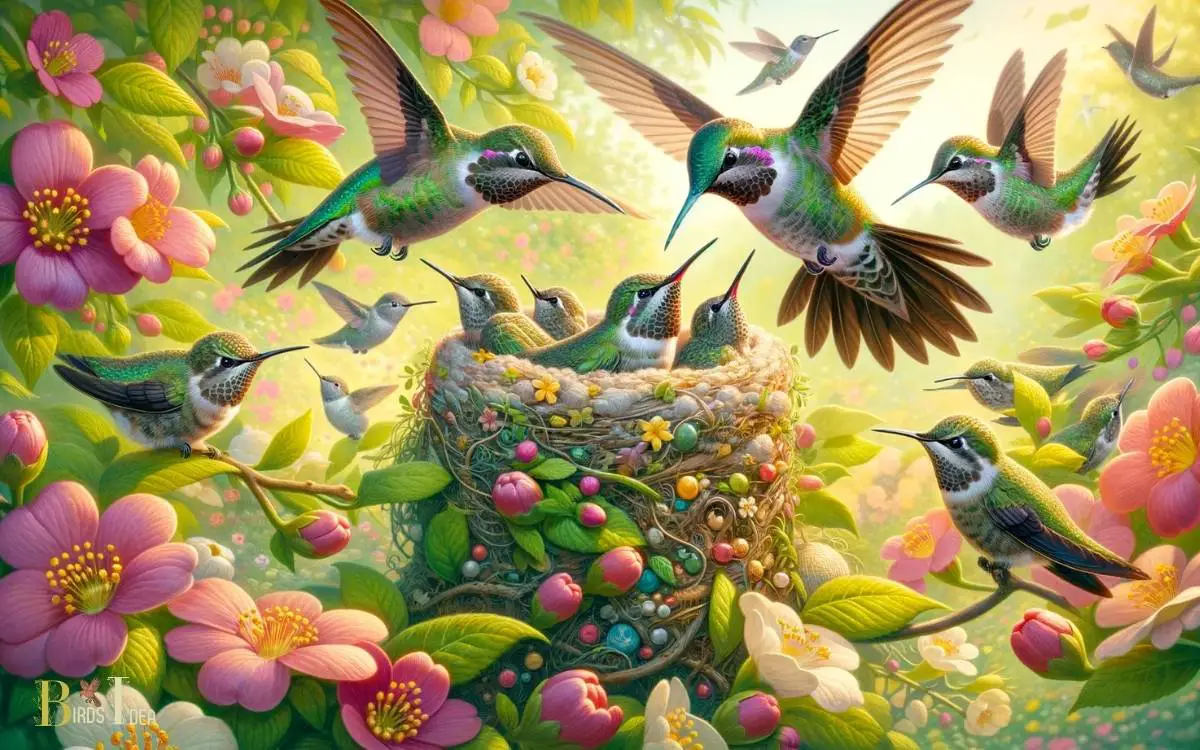
Key Takeaway
The Beginnings of Nest Building
Commencing the process of nest building, Anna’s hummingbirds meticulously gather and weave materials to construct a secure and comfortable nesting site for their offspring.
These tiny birds start by collecting soft, fluffy materials such as plant fibers, moss, and even bits of lichen. They intricately weave these together using spider silk and other sticky substances to bind the structure.
The female Anna’s hummingbird then carefully molds the materials into a cup-shaped nest, using her body to shape and compact the materials.
This process is not only essential for the protection and insulation of the eggs but also ensures a sturdy foundation for the growing chicks.
The attention to detail and precision in constructing the nest showcases the remarkable instinctual behavior and engineering skills of these remarkable birds.
Nest Construction Techniques
The nest construction process of Anna’s hummingbirds involves meticulously gathering and weaving materials to create a secure and comfortable nesting site for their offspring.
Anna’s hummingbirds are known for their elaborate and intricate nests, which are built using a variety of materials such as plant fibers, feathers, and spider silk.
The female hummingbird meticulously weaves these materials together to form a cup-shaped nest, often using lichens or moss to camouflage the exterior. The elasticity of spider silk provides flexibility to the nest, allowing it to expand as the chicks grow.
The insulative properties of the nest materials help regulate the temperature for the eggs and nestlings. Once completed, the nest provides a safe and nurturing environment for the upcoming brood.
This meticulous process showcases the remarkable skill and dedication of these tiny birds in creating a suitable home for their young.
Incubation and Nest Maintenance
During incubation, the female Anna’s hummingbird diligently tends to her eggs, maintaining the nest’s temperature and protecting it from potential threats.
She spends most of her time keeping the eggs warm by sitting on them, a process known as incubation. This is crucial for the successful development of the embryos.
Additionally, the female regularly inspects the nest and makes necessary repairs to ensure its structural integrity.
She removes any debris or waste to maintain a clean environment for the eggs. The female also defends the nest against predators and territorial intruders, displaying remarkable courage and agility.
These behaviors showcase the remarkable dedication and instinctual care that the female Anna’s hummingbird exhibits during the incubation period.
Feeding and Growth of Chicks
Throughout the nesting season, the female Anna’s hummingbird takes on the vital role of feeding and nurturing the growing chicks in the nest.
The chicks are fed a diet consisting primarily of regurgitated nectar and insects, providing them with the necessary nutrients for rapid growth.
The mother carefully regulates the temperature of the nest, ensuring optimal conditions for the chicks’ development.
As the chicks grow, their demand for food increases, and the mother tirelessly forages for nectar and small insects to meet their needs. The chicks undergo rapid growth and development, reaching maturity in just a few weeks.
During this time, they become increasingly independent, preparing to leave the nest and begin their own lives as adult hummingbirds.
The feeding and growth of chicks is a critical phase in the nesting season, ensuring the survival and future success of the Anna’s hummingbird population.
Fledging and First Flights
As the fledging stage approaches, Anna’s hummingbird chicks become increasingly active, flapping their wings and testing their flight muscles.
This period presents challenges as the young birds must learn to navigate the world outside the nest, facing potential predators and unfamiliar surroundings.
Throughout this critical phase, the parental care provided by the adult hummingbirds is evident as they continue to monitor and support their fledglings in their first flights.
Challenges of First Flights
At approximately 20 days old, Anna’s hummingbird chicks face the formidable challenge of their first flights, navigating the transition from the safety of the nest to the perils of the outside world.
This phase presents several challenges:
- Physical Preparedness: The chicks must develop the strength and coordination necessary for sustained flight. This includes building up their flight muscles and mastering the complex aerial maneuvers essential for survival.
- Environmental Awareness: The young hummingbirds need to quickly learn to recognize potential threats, such as predators and adverse weather conditions, while also locating food sources and suitable perches.
Successfully navigating these challenges is crucial for the fledglings’ survival and lays the foundation for their future as independent, thriving members of the hummingbird community.
Parental Care During Fledging
During the fledging and first flights phase, parental care is essential for the young Anna’s hummingbirds’ successful transition from the nest to independent flight and survival in the outside world.
The parents continue to provide food and guidance to their fledglings. They demonstrate flight maneuvers, such as mid-air stops and starts, and feed the young birds with nectar and small insects.
The fledglings are encouraged to practice their flying skills, gradually gaining strength and agility.
The parents also play a crucial role in protecting their fledglings from potential predators, often using distraction techniques to lead predators away from the vulnerable young birds.
This parental care is vital for the fledglings’ development and readiness for life outside the nest, ensuring their best chances for survival and successful integration into the hummingbird population.
Parental Care and Protection
When do Anna’s hummingbirds begin to exhibit parental care and protection behaviors? Anna’s hummingbirds typically begin to exhibit parental care and protection behaviors as soon as the eggs hatch.
The male and female both take part in raising the young, with the female primarily responsible for keeping the nest and chicks warm and the male taking on the role of providing food and defending the territory.
Parental Care Behaviors
- Feeding: Both parents take turns feeding the chicks a diet primarily consisting of regurgitated nectar and insects, ensuring they receive the necessary nutrients for growth and development.
- Nest Protection: The parents fiercely defend the nest from potential predators, using their agility and speed to ward off threats and keep the chicks safe until they fledge.
Nesting Season Challenges
Throughout the nesting season, Anna’s hummingbirds encounter various environmental and territorial obstacles that impact their ability to successfully raise their young.
The availability of suitable nesting sites and resources such as nectar and insects plays a critical role in their reproductive success.
Competition for limited resources and territory from other hummingbirds and bird species can lead to aggressive territorial behavior, potentially affecting the survival of the nestlings.
In addition, environmental factors such as extreme weather events, habitat destruction, and exposure to pesticides pose significant challenges to the nesting success of Anna’s hummingbirds.
These challenges highlight the delicate balance between the natural environment and the survival of these remarkable birds.
Understanding these challenges underscores the critical need for conservation efforts and awareness to protect the nesting habitats of Anna’s hummingbirds and mitigate the impact of environmental threats.
Conservation Efforts and Awareness
Conservation efforts for Anna’s Hummingbirds focus on protecting their nesting habitats, which are often threatened by urban development and habitat destruction.
Public education initiatives play a crucial role in raising awareness about the importance of preserving these habitats and creating bird-friendly environments in urban and suburban areas.
By increasing awareness and implementing conservation measures, we can help ensure the continued survival of Anna’s Hummingbirds and other wildlife species that share their ecosystems.
Nesting Habitat Protection
Preservation of nesting habitats is a critical component of efforts to ensure the long-term survival of Anna’s hummingbirds.
Protecting nesting habitats involves a multi-faceted approach that includes:
Conservation Efforts
- Collaborating with local authorities and conservation organizations to designate and protect critical nesting areas.
- Implementing regulations and guidelines to minimize human disturbances in these habitats during the nesting season.
Effective conservation efforts not only safeguard the immediate nesting sites but also contribute to the overall health of ecosystems where these habitats are located.
By prioritizing the protection of these crucial areas, we can help secure the future of Anna’s hummingbirds and other species that share these habitats.
Public Education Initiatives
An essential aspect of promoting the long-term survival of Anna’s hummingbirds is the implementation of targeted public education initiatives focused on conservation efforts and raising awareness about the importance of nesting habitat protection.
These initiatives involve disseminating information about the threats to nesting habitats, such as urban development and habitat destruction, and advocating for sustainable practices.
Educational programs are designed to engage communities in citizen science projects, encouraging them to participate in monitoring and protecting nesting sites.
By collaborating with local schools, nature centers, and community organizations, these initiatives aim to foster a sense of stewardship and responsibility towards the preservation of nesting habitats.
Furthermore, these programs emphasize the significance of planting native vegetation to provide food and shelter for these hummingbirds, ultimately contributing to the conservation of their nesting areas.
Conclusion
The nesting season of Anna’s hummingbird is a remarkable display of dedication, skill, and resilience. The intricate construction of the nest, the meticulous care of the eggs, and the tireless feeding of the chicks all contribute to the survival of this species.
Like a delicate tapestry being woven in the air, the nesting season of Anna’s hummingbird is a testament to the beauty and complexity of nature’s design.

